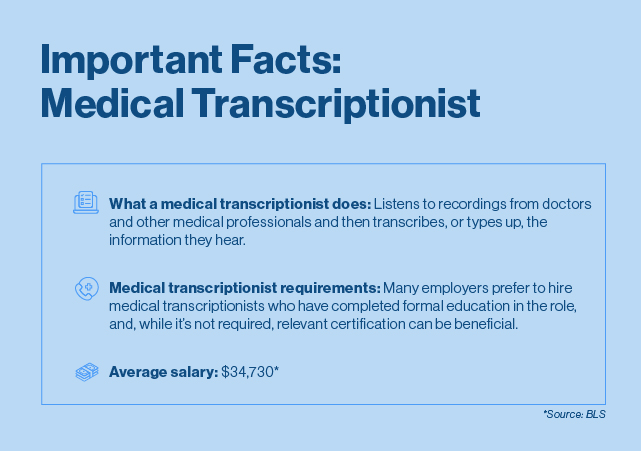
Guide to Becoming a Medical Transcriptionist: Salary, FAQs, and Requirements
Not sure if medical transcription is the right career for you? In this blog, you’ll learn more about what a medical transcriptionist does, the average salary for medical transcriptionists, and how to become one!
Oct 13, 2023
8 min read
Reviewed by Becky Byrns, Program Manager, Healthcare Documentation, Health and Wellness. Our contributors help us maintain the highest standards of accuracy and transparency. Learn more about our editorial guidelines.
If you’re looking for a healthcare career that allows you to work in an in-demand industry without having to work with patients, becoming a medical transcriptionist could be the right move. Here’s what you need to know about what medical transcriptionists do, the average salary, and what you need to do to qualify for the job.
What is a medical transcriptionist?
A medical transcriptionist is someone who listens to voice recordings from doctors and other healthcare professionals and types up what they hear as formal documents or reports. They may also be responsible for reviewing and editing medical documents created using speech recognition software and apps.

Medical transcriptionists can work in healthcare offices, for insurance companies, hospitals, or for transcription services companies. They can also be self-employed. Generally, the job is pretty similar no matter where they work, though the work schedule can vary.
In a typical day, medical transcriptionists will receive several digital files with voice recordings that need to be translated into written form. They’ll translate what the doctors say, including writing out any shorthand or abbreviations, into medical documents that can be included in a patient's electronic medical records.
Medical transcriptionist job duties include
- Listening to recordings from physicians or other healthcare professionals
- Transcribing recordings into typed notes for patient records, discharge summaries, and other healthcare records
- Reviewing and editing drafts from speech recognition software to ensure accuracy
- Submitting reports to doctors and other healthcare professionals
- Entering reports into electronic health records (EHR) systems
Read more: Smart Ways to Use Your Medical Transcriptionist Degree
How to become a medical transcriptionist
Though it’s not required, most employers of medical transcriptionists prefer to hire people – especially those new to the job – who have had formal education in the role. That means earning a career diploma or certificate as a medical transcriptionist, which can take less than a year depending on the program you take.
The steps to become a medical transcriptionist include
- Earn your high school diploma or equivalent
- Enroll in a medical transcription training program to learn medical terminology, how to use common transcription software, how to navigate and use electronic health records, and more
- Sit for the Registered Healthcare Documentation Specialist (RHDS) exam offered by AHDI
- Update your resume to include your education and credentials to help you stand out to potential employers
- Gain practical experience in an entry-level job
- Continue to learn and adapt in your medical transcription job
Medical transcriptionist requirements
The requirements to become a medical transcriptionist include
- Earning a high school diploma or equivalent (GED, etc.)
- Completing a medical transcriptionist training program
- Becoming certified
Good medical transcriptionists should also have strong knowledge of common medical terminology, common abbreviations used in healthcare, and how to work with electronic medical records.
Read more: Careers I Can Train for in Six Months or Less
Do you need a certification to become a medical transcriptionist?
After completing a medical transcriptionist training course, it also helps to become certified. Certification isn’t required, either, but it can help you stand out to potential employers when you’re applying for jobs.
The usual certification that medical transcriptionists earn is the Registered Healthcare Documentation Specialist (RHDS) exam offered by the Association for Healthcare Documentation Integrity (AHDI).
What is a registered healthcare documentation specialist (RHDS)?
A registered healthcare documentation specialist is someone who has become certified by passing the Registered Healthcare Documentation Specialist exam. You can become a healthcare documentation specialist, which is another job title for medical transcriptionists, without certification but cannot call yourself “registered” unless you take and pass the certification exam.
How do you get the RHDS certification?
To earn RHDS certification, you’ll need to sit for and pass the RHDS exam. This exam is a voluntary credential that isn’t required but can be a great resume booster for those looking to start a career as a healthcare documentation specialist.
What is the RHDS exam?
The RHDS exam is a test that measures competency in the skills you need to be a successful medical transcriptionist, or healthcare documentation specialist. It covers essential skills such as
- Medical terminology
- Basic anatomy and physiology
- Common medical transcription guidelines and practices
- Written communication skills like good grammar and punctuation
- Health record privacy and security
- Use of speech recognition technology
The test is 120 questions and includes both multiple-choice and short answer questions. The short answer portion involves listening to audio clips and transcribing what you hear or filling in the blanks of incomplete transcripts.
To best prepare for the RHDS exam, you’ll want to make sure to complete a medical transcription training program to learn to skills and knowledge that are essential on the job. It can also be helpful to review the notes you took during your program to make sure they’re fresh in your mind before sitting for the exam.
Read more: You’re Interested in a Career in Healthcare – But Which Job is Right for You?
Medical transcription career path: who is this job perfect for?
Medical transcription jobs can be the perfect fit for someone who has strong critical thinking, computer, listening, and writing/typing skills. Since the job is very independent and doesn’t require working within a team, interacting with patients, or talking with medical providers, it can be a great role for people who prefer to work alone in quiet environments. For introverts, it could be a dream job!
Since there are many opportunities to work from home as a medical transcriptionist, it can be a great job for moms or people looking for part-time work to earn extra money.
Medical transcriptionist salary by state
The average salary for a medical transcriptionist was $34,730 in 2022. The lowest 10% of medical transcriptionists in the United States earned less than $24,340 while the highest 10% in the field earned more than $51,280.*
Medical Transcription Salary By State - How much do medical transcribers make?
| State | Annual Mean Wage | Annual Hourly Wage |
|---|---|---|
| Alaska | $44,730 | $21.51 |
| Alabama | $31,730 | $15.74 |
| Arkansas | $32,770 | $15.76 |
| Arizona | $32,490 | $15.62 |
| California | $34,220 | $16.45 |
| Colorado | $38,110 | $18.32 |
| Connecticut | $49,810 | $23.95 |
| Delaware | $34,540 | $16.61 |
| Florida | $31,710 | $15.25 |
| Georgia | $28,500 | $13.70 |
| Hawaii | $43,230 | $20.78 |
| Iowa | $33,600 | $16.15 |
| Idaho | $30,670 | $14.75 |
| Illinois | $32,830 | $15.78 |
| Indiana | $32,650 | $15.70 |
| Kansas | $33,870 | $16.29 |
| Kentucky | $34,520 | $16.59 |
| Louisiana | $36,010 | $17.31 |
| Massachusetts | $39,950 | $19.21 |
| Maryland | $40,290 | $19.37 |
| Maine | $37,630 | $18.09 |
| Michigan | $31,390 | $15.09 |
| Minnesota | $44,390 | $21.34 |
| Missouri | $35,060 | $16.86 |
| Mississippi | $32,090 | $15.43 |
| Montana | $43,640 | $20.98 |
| North Carolina | $31,140 | $14.97 |
| North Dakota | $33,940 | $16.32 |
| Nebraska | $36,950 | $17.76 |
| New Hampshire | $39,060 | $18.78 |
| New Jersey | $43,990 | $21.15 |
| New Mexico | $28,150 | $13.53 |
| Nevada | $37,520 | $18.04 |
| New York | $34,600 | $16.64 |
| Ohio | $29,390 | $14.13 |
| Oklahoma | $37,080 | $17.83 |
| Oregon | $39,520 | $19.00 |
| Pennsylvania | $37,140 | $17.86 |
| Rhode Island | $36,160 | $17.39 |
| South Carolina | $36,180 | $17.40 |
| South Dakota | $39,350 | $18.92 |
| Tennessee | $29,980 | $14.41 |
| Texas | $30,170 | $14.50 |
| Utah | $36,880 | $17.73 |
| Virginia | $34,750 | $16.71 |
| Vermont | $42,380 | $20.38 |
| Washington | $43,380 | $20.86 |
| Wisconsin | $39,120 | $18.81 |
| West Virginia | $32,160 | $15.46 |
| Wyoming | $42,890 | $20.62 |
Do medical transcriptionists work from home?
Medical transcription is one of the few healthcare roles in which you may have the opportunity to work from home. Since most of the tasks you complete are done on a computer and do not involve interaction with patients, or even the people who’ve created the voice recordings you’re transcribing, there’s not much need to work in an office setting.
Today, there are more remote jobs available than ever across the country, so it’s more than likely that you’d be able to find work from home medical transcription jobs to apply for relatively easily.
Read more: Careers That Allow You To Work From Home
How to get a job as a medical transcriptionist
To get a job as a medical transcriptionist, you’ll want to complete a training program and earn certification so you can build a strong resume as someone who is new to the field. Once you’ve got your credentials and have updated your resume (you can find out more about writing a good resume in our blog), you’ll want to start searching for jobs. To make sure you get the most out of your job search, try these tips:
- Create a LinkedIn profile if you don’t already have one. LinkedIn is a great place to share your accomplishments and skills, network with other professionals in your industry, and search for jobs.
- Use more than one job search site. Don’t just stick with one site when you’re searching for jobs. Some employers may post on all job posting sites, but others may prefer to use one to find applicants.
- Use social media for your job search. More and more employers – especially in your local area – are using Facebook to search for job applicants. Make sure you’re keeping your eyes open when you’re scrolling through your timeline for any relevant job posts that pop up.
It also helps to tweak your resume for different job posts. Look at what the company mentions in their description of the job and the requirements. Try to use the keywords they use within your descriptions of your previous work experience or education.
Become a medical transcriptionist online
If all this information has convinced you that becoming a medical transcriptionist is the right career move for you, your next step is to build the skills you need to be successful in your job search and in the role. With Penn Foster’s online Medical Transcriptionist Career Diploma, you can learn medical terminology, pharmacology, medical billing, and transcription skills from home, around your schedule. Your curriculum will also prepare you to sit for the RHDS exam, so once you graduate you can earn a credential that can help you stand out when you’re applying for jobs!
To learn more about becoming a medical transcriptionist online, or to take the first steps toward a new career, reach out to our Admissions Specialists today at 1-888-427-6500!
Not sure that medical transcription is right for you? Check out more career options by reading our in-depth career guides:
How to Become an Administrative Assistant
How to Become a Dental Assistant
Your Guide to Medical Assistant Duties
* Bureau of Labor Statistics, U.S. Department of Labor, "Medical Transcriptionists." Occupational Outlook Handbook, accessed accessed September 19, 2023.




